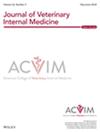Fungal Rhinosinusitis in Cats in the United Kingdom: 34 Cases (2013–2022)
Abstract
Background
Fungal rhinosinusitis in cats is an uncommon condition with sparse literature regarding the presentation, causative agents, diagnosis, treatment, and prognosis within the UK.
Hypothesis/Objectives
To describe and report the presenting clinical signs, diagnostic imaging findings, treatment approach, and outcome of cats diagnosed with fungal rhinosinusitis in the UK.
Animals
Thirty-four client-owned cats were diagnosed with fungal rhinosinusitis.
Methods
Retrospective multicenter observational study. Cases presenting at 10 UK referral centers between January 2013 and December 2022 were retrospectively recruited.
Results
Median duration of clinical signs was 3 months (0.5-42-months). The most common signs were sneezing (27/34, 79%) and nasal discharge (21/34, 62%). Turbinate lysis was present in 27/34 cases (79%) and always involved the caudal nasal cavity. Osteolysis of the frontal bone, orbit, or cribriform plate was observed in 16/34 cases (47%). At least two tests from fungal culture, panfungal PCR, and histopathology were performed in all cases, and in 8/34 cases (24%) only one was positive. The treatment approach varied, with debridement, topical clotrimazole, and systemic azole therapy used alone or in various combinations, and repeat treatment occurred in 9/34 cases (26%). Clinical remission > 90 days after treatment was found in 9/24 cases (38%), but case fatality rates were low, with 3/34 cases (9%) dying with clinical disease during available follow-up.
Conclusions and Clinical Importance
Fungal rhinosinusitis should be considered in cats of any age with clinical signs of nasal disease. The prognosis from this data appears guarded for cats with fungal rhinosinusitis, with less than 50% of cats achieving long-term clinical remission.


 求助内容:
求助内容: 应助结果提醒方式:
应助结果提醒方式:


